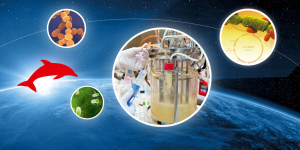Nanobiotechnology
Particles for Bioconjugation, Assay Development, and Flow
BIOZOL provides with a huge variety of high qualilty nanoparticles and microparticles for your biopharmaceutical research and development.
To offer you the best possible products, service and expertise, we work together with manufacturers, which are experts in the field nanotechnology based life science applications:
Selected Applications for Micro- and Nanoparticles in Life Sciences:
Bioconjugation with nanoparticles
Bioconjugated nanoparticles are used in a wide range of methods like assay development, cell sorting, a.o. An ideal bioconjugation system should be based on specific interactions between the biological target molecule and tailored modifications of the nanoparticle surface, producing specific biomolecule attachment in a favourable orientation for catalysis (enzymes) or binding (antibodies, receptors), while avoiding nonspecific protein adsorption.
Our partners offer standardized kits for an easy, quick and highly-efficient conjugation of nanoparticles and biomolecules:
NanoComposix BioReady Covalent Gold Conjugation Kits
Nanoimmunotech LinkOriented Kits for bioconujugation with magnetic nanoparticles
Also BIOZOL provides an affordable, high-quality custom antibody and protein conjugation service, with easy order via our service form.
Nanoparticles for Lateral Flow & Diagnostic Applications
 Nanoparticles play an important role in a wide range of diagnostic devices and testing methods to increase performance (e.g. sensitivity, speed) or to enable a detection method that would not be possible without nanotechnology. Plasmonic nanoparticles are extremely strong absorbers and scatters of light and are used in lateral flow diagnostics, surface enhanced spectroscopy, cell labeling, and color changing sensors. Nanoparticles with electrochemical, magnetic, or fluorescent properties response are also used in many different diagnostic applications.
Nanoparticles play an important role in a wide range of diagnostic devices and testing methods to increase performance (e.g. sensitivity, speed) or to enable a detection method that would not be possible without nanotechnology. Plasmonic nanoparticles are extremely strong absorbers and scatters of light and are used in lateral flow diagnostics, surface enhanced spectroscopy, cell labeling, and color changing sensors. Nanoparticles with electrochemical, magnetic, or fluorescent properties response are also used in many different diagnostic applications.
NanoComposix Diagnostic Nanoparticles
BioReady High Sensitivity Gold Conjugation Kit for Lateral Flow
Webinar on Lateral Flow Assay Optimization
Flow Cytometry: Calibration and Performance Tracking with Microparticles
SPHERO™ Calibration Particles are versatile, stable, economical and convenient to use. They contain a mixture of fluorochromes which are spectrally similar to many of the fluorochromes used in flow cytometry. As a result, they are used for routine alignment, day-to-day performance verification and long term performance tracking of several channels of flow cytometers in one run.
Spherotech Range of Microparticles
Application Note SPHERO™ Calibration Particles
Fluorescent Nanoparticle for Live Cell Imaging
.jpg) GlowDot40 Protein-Based Fluorescent Nanoparticles from Kerafast are readily taken up by cells, biocompatible, and offer a variety of wavelengths to choose from multi-channel live cell imaging. They show low toxicity, high biocompatibility, and are completely biodegradable. GlowDot Nanoparticles were tested in HeLa, A549, HN12 cells.
GlowDot40 Protein-Based Fluorescent Nanoparticles from Kerafast are readily taken up by cells, biocompatible, and offer a variety of wavelengths to choose from multi-channel live cell imaging. They show low toxicity, high biocompatibility, and are completely biodegradable. GlowDot Nanoparticles were tested in HeLa, A549, HN12 cells.
GlowDot10 single protein nanoparticles retain the structure and function of native protein used. They exhibit superior thermal stability to native proteins, as tested with steam sterilization studie, and are likely to be non-toxic to most cells, as metal ion-free.
Kerafast GlowDot40 Protein-Based Fluorescent Nanoparticles
Kerafast GlowDot10 Protein-Based Fluorescent Nanoparticles
Nanocarriers for Drug Delivery
Nanocarriers are designed to transport active ingredients, thereby penetrating biological barriers such as the walls of blood vessels, or the blood-brain barrier, and release the active ingredients precisely in organs and other tissues.
Nanoprobes' gold nanoparticles, f.e., are being delivered to cancers for better diagnosis and treatment, using a peptide that targets the low pH environment of tumors: pH Low Insertion Peptide (pHLIP) responds to the acidic environment that differentiates virtually all tumor cells from normal cells: it folds to form a transmembrane alpha-helix that then inserts into the cell membrane. If the peptide is bound to an appropriate payload, it will then transfer its cargo across the membrane and into the tumor. Nanogold® reagents from Nanoprobes were particularly suited for delivery to the tumor. Because the gold nanoparticle is uncharged, it won't affect the key interaction of pHLIP with the acidic cancer environment. Equally important is the covalent mode of conjugation, which does not alter the properties of the pHLIP, and makes a very small and stable conjugate that readily crosses membranes. (Yao et al., PNAS 2013)
Nanogold® reagents from Nanoprobes
Nanoparticles for Nanotoxicology & Nanosafety
Nanotoxicology is the study of the toxicity of nanomaterials and focuses on how the size and unique properties of nanoparticles influences their impact on human health and the environment. Nanosafety is a field that aims to understand the physical and chemical characteristics that can be engineered into a particle in order to maximize its safety. Together these two disciplines provide fundamental research results to support the rapidly increasing use of engineered nanoparticles in ways that are safe and sustainable.
To understand the structure-activity relationship of nanoparticles interacting with biological systems, it is important to conduct studies with precisely engineered nanomaterials that are highly characterized.
BioPure™ nanoparticles from NanoComposix are purified, concentrated, sterilized, & endotoxin-free nanoparticles with a range of size & surface options. They enable investigation of particle effects without interference from residual reactants.
NanoComposix BioPure™ nanoparticles
Webinar on Nanosafety and Nonotoxicology Research
05.05.2021

Cell Manipulation
MDR Approval for Medical Devices

Labortops #2
Super Sale: up to 88% off labware

Obesity and Metaboli...
Research Reagents from Rockland, GeneTex and more

Spring Promo
Up to 30 % off Antibodies and ELISA kits

Protein Expression
MoBiTec Cloning and Expression Vectors






